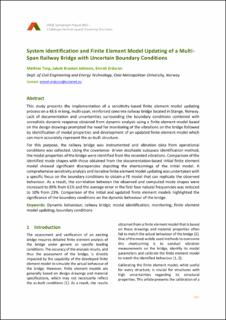System Identification and Finite Element Model Updating of a Multi- Span Railway Bridge with Uncertain Boundary Conditions
Chapter, Peer reviewed, Conference object
Published version
Permanent lenke
https://hdl.handle.net/11250/3083197Utgivelsesdato
2022Metadata
Vis full innførselSamlinger
Sammendrag
This study presents the implementation of a sensitivity-based finite element model updating process on a 48.6 m long, multi-span, reinforced concrete railway bridge located in Stange, Norway. Lack of documentation and uncertainties surrounding the boundary conditions combined with unrealistic dynamic response obtained from dynamic analysis using a finite element model based on the design drawings prompted the need for monitoring of the vibrations on the bridge followed by identification of modal properties and development of an updated finite element model which can more accurately represent the as-built structure. For this purpose, the railway bridge was instrumented and vibration data from operational conditions was collected. Using the covariance- driven stochastic subspace identification method, the modal properties of the bridge were identified from the recorded vibrations. Comparison of the identified mode shapes with those obtained from the documentation-based initial finite element model showed significant discrepancies depicting the shortcomings of the initial model. A comprehensive sensitivity analysis and iterative finite element model updating was undertaken with a specific focus on the boundary conditions to obtain a FE model that can replicate the observed behaviour. As a result, the correlation between the observed and computed mode shapes were increased to 89% from 61% and the average error in the first four natural frequencies was reduced to 10% from 23%. Comparison of the initial and updated finite element models highlighted the significance of the boundary conditions on the dynamic behaviour of the bridge.
